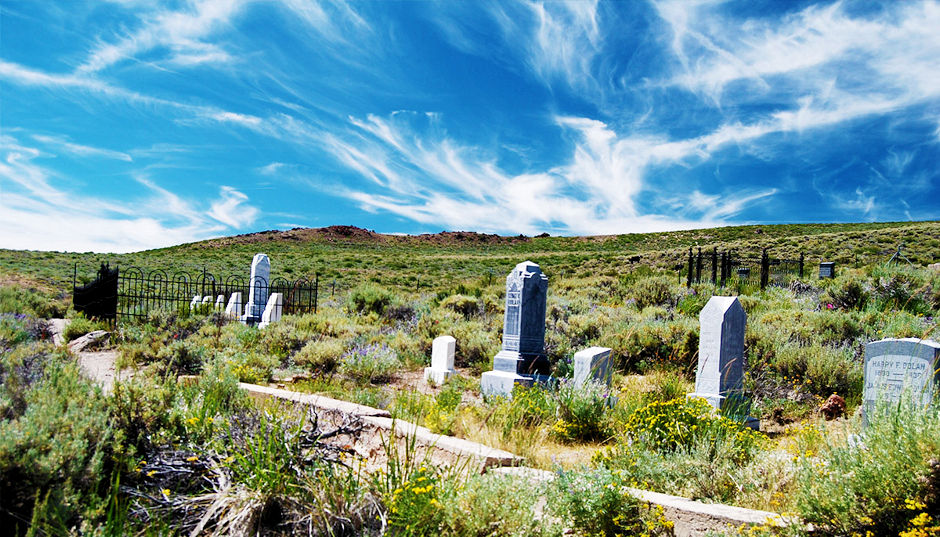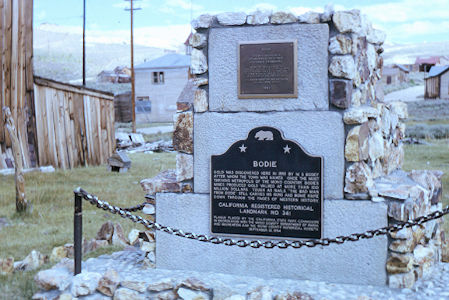
Bodie State Historic Park monument - August 25, 1962
I first visited Bodie on August 25, 1962 while it was still privately owned by J. S. Cain and the Standard Consolidated Mine and returned in August 1965. A 1932 fire destroyed 70% of the town buildings. Town banker James Stewart Cain began buying properties as people moved away and preserved the town for all to enjoy. At the time I visited, none of the buildings were open to enter but could be observed thru windows.
In 1962 the State of California took over ownership and improved the protection and opened some of the historic facilities for public viewing that had previously not been open. The Bodie State Historic Park website provides the latest information. Bodie has also been designated a National Historic Landmark District by the National Park Service. The Park is a genuine California gold-mining ghost town. Visitors can walk down the deserted streets of a town that once had a population of roughly 10,000 people.
Read details about Bodie's history here and here.
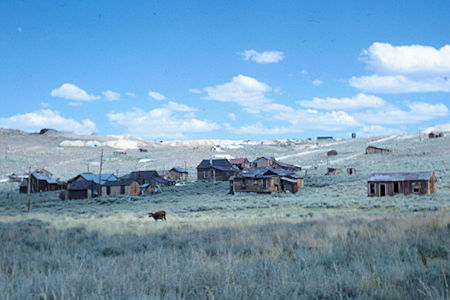
Bodie State Historic Park - August 25, 1962
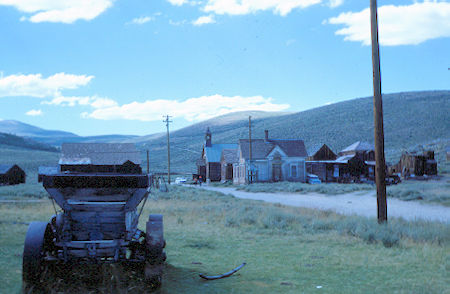
Bodie State Historic Park - August 25, 1962
The non-profit Bodie Foundation helps the State Park people maintain the town. This includes raising money for various projects to help maintain buildings suffering from age and weather while keeping them in a state of "arrested decay". Be sure to check here for information on Projects where you can help.
The town is named for W.S. Body (or Bodey), who had discovered small amounts of gold in hills north of Mono Lake. In 1875, a mine cave-in revealed a rich vein of ore, which led to purchase of the mine by the Standard Company in 1877. People flocked to Bodie and transformed it from a town of a few dozen to a boomtown.
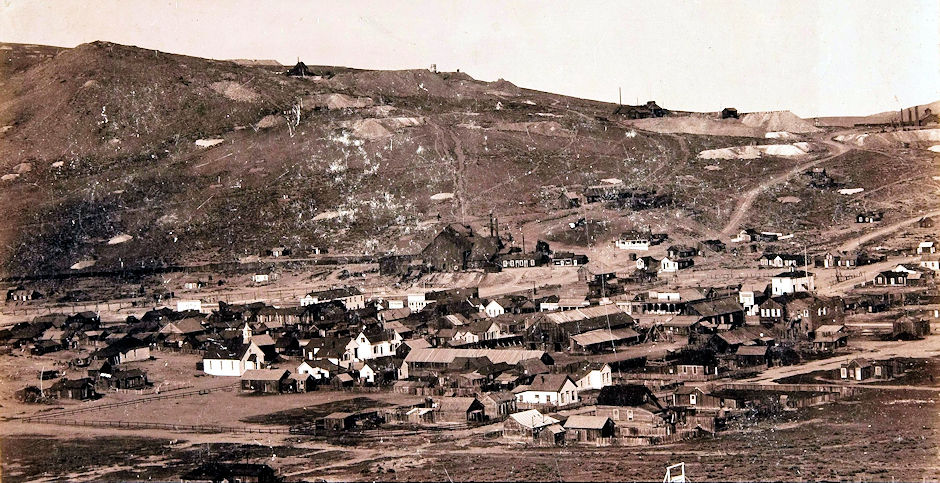
Bird's Eye View photograph of Bodie, California in the 1890s. Looking east from the cemetery
Created from original - William Thompson, Virginia City, Nevada., Public domain, via Wikimedia Commons
In 1881, Bodie's "bust" began and the town's population declined drastically. The town's population continuing to decline until only a few remained. Mining officially ceased in Bodie in 1942, the final nail in the coffin for Bodie's township. Two large fires in 1892 and 1932 reduced the town's remaining structures down to less than 10% of the 2,000 structures that once stood.
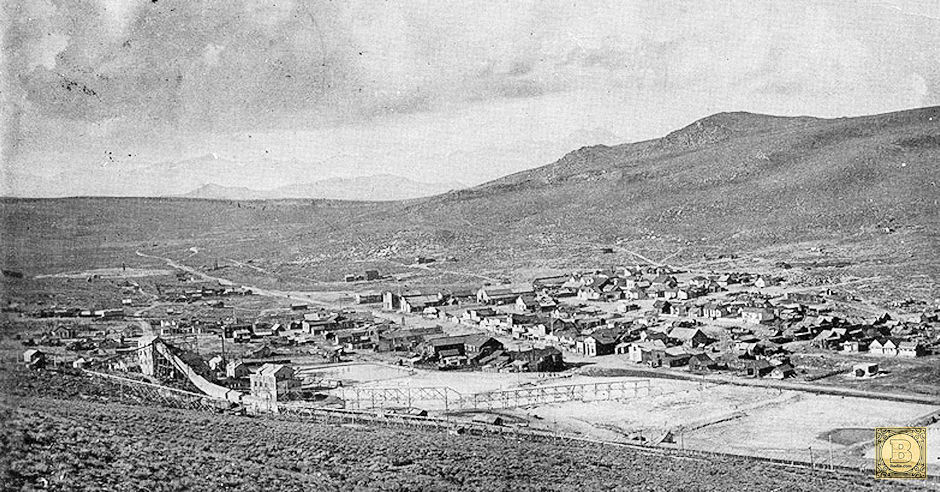
Town of Bodie about 1910 by L. A. Larson
Only a small part of the town survives. Interiors remain as they were left and stocked with goods. Designated as a National Historic Site and a State Historic Park in 1962, the remains of Bodie are being preserved in a state of "arrested decay". Today this once thriving mining camp is visited by tourists, howling winds and an occasional ghost.

for Projects where you can help
www.bodiefoundation.org (760) 932-7574
The following video covers the town very well in 2011 along with a few ghosts at the end:
Bodie Historic District
From the National Historic Landmark District website
Bodie, the best-preserved ghost town from the California Gold Rush, is located 7 miles south of Bridgeport, California at an elevation of 8,379 feet in the Sierra Nevada Mountains. Now in a state of arrested decay, Bodie is an excellent example of an American West boomtown and the accompanying lifestyle that developed in the western mining towns. As part of the California Gold Rush, many Chinese came to live and work in Bodie during its early years. More than 100 historic buildings remain in the area to convey what life in Bodie was like between its founding in 1859 and its end in 1942, when mining was suspended and the last Bodie residents left the town.
Gold was discovered in the Mono Lake region of California in 1852, and placer gold was discovered at the future site of Bodie in the Mono Basin in July 1859. William S. Bodey and E.S. Taylor discovered the gold, staked their claim in the harsh high desert environment, and established camp. Bodey died during a snowstorm in the winter of 1859-1860 on a supply trip, and the Bodie Mining District organized in 1860 in his honor.
The town remained relatively small with fewer than 20 buildings until the Bunker Hill Mine discovered large deposits of gold and silver at Bodie in 1876. This bonanza resulted in a population boom as people streamed into Bodie in search of riches. By 1879, the town had grown to over 250 buildings and 10,000 residents, encompassing houses, a school, a Wells Fargo bank, four volunteer fire companies, hotels, a jail, cemeteries, stores, churches, newspapers, a mortuary, and other structures that supported the large community.
Main Street lengthened to over a mile of densely populated one and two story buildings. The total estimated output of the Bodie mines between 1876 and 1941 was $70 million, with the high point being 1879. Shortly thereafter the promises of riches from newer mines started to lure Bodie's residents away.
By the 1880's, the city had developed a tough reputation, even spawning a popular expression "a bad man from Bodie," which meant someone who was unusually unpleasant. With the boom came breweries, saloons, brothels, a popular red light district, and gambling dens, which led to an increase in nightly shootings, stabbings, and brawls. The city developed a special notoriety for its overly violent residents. It was even infamous with children, one of whom wrote in their diary, "Goodbye God, I'm going to Bodie."
Many Chinese immigrants came to Bodie from Southern China as contract laborers in 1878. They settled on the outskirts of the town in a Chinese community, or "Chinatown," northwest of Main and King Streets. The Chinese residents of Bodie faced discrimination in the local mines, which forced them to turn to service occupations for employment. They operated laundries, peddled vegetables (shipped in by express), supplied charcoal, and provided most of the wood used in the town.
Bodie's Chinatown was made up of two and three story wooden buildings and included general stores, homes, laundries, boarding houses, a restaurant, opium dens, a Taoist temple, saloons, and gambling establishments. Newspaper accounts depicted a thriving community and mentioned Chinese New Year's celebrations and large funerals. At its peak in 1880, several hundred Chinese lived in Bodie's Chinatown.
Bodie's slow decline began in 1879 and, as was typical in 19th century mining communities, continued with a series of booms and busts for the next several decades. As the supply of mineable material became scarce, people began to leave the area. By 1886, Bodie's population had fallen to approximately 1,500 residents. A fire in July 1892, destroyed a large section of Main Street, but a rebuilt business district on a smaller scale adapted to the needs of the city.
Several of the surviving buildings still located on Main Street were probably moved from another part of Bodie to their present location after the 1892 fire. Another fire destroyed parts of the Main Street business district downtown in June 1932. The War Production Board suspended mining operations in 1942, and the last residents of Bodie left shortly thereafter.
After its abandonment, its location and isolation from the outside world helped preserve Bodie as one of the best examples of mining ghost towns in the West. Bodie became a National Historic Landmark District in 1961 and a State Historic Park in 1962. Today, 110 buildings still stand in and around the town and building interiors remain as they were left, still stocked with goods and furniture. Bodie Historic District is in a state of arrested decay, with its buildings and other aspects of the community left as they were when residents abandoned the community to its past.
Bodie Historic District is located in Bodie, CA and the Bodie State Historic Park. For more information, visit the Bodie State Historic Park website, the Bodie Foundation website. Bodie Historic District has been documented by the National Park Service's Historic American Buildings Survey.
Use Mouse to move/pan Map. Use Mouse Wheel to enlarge/magnify Map.
or Use these controls:
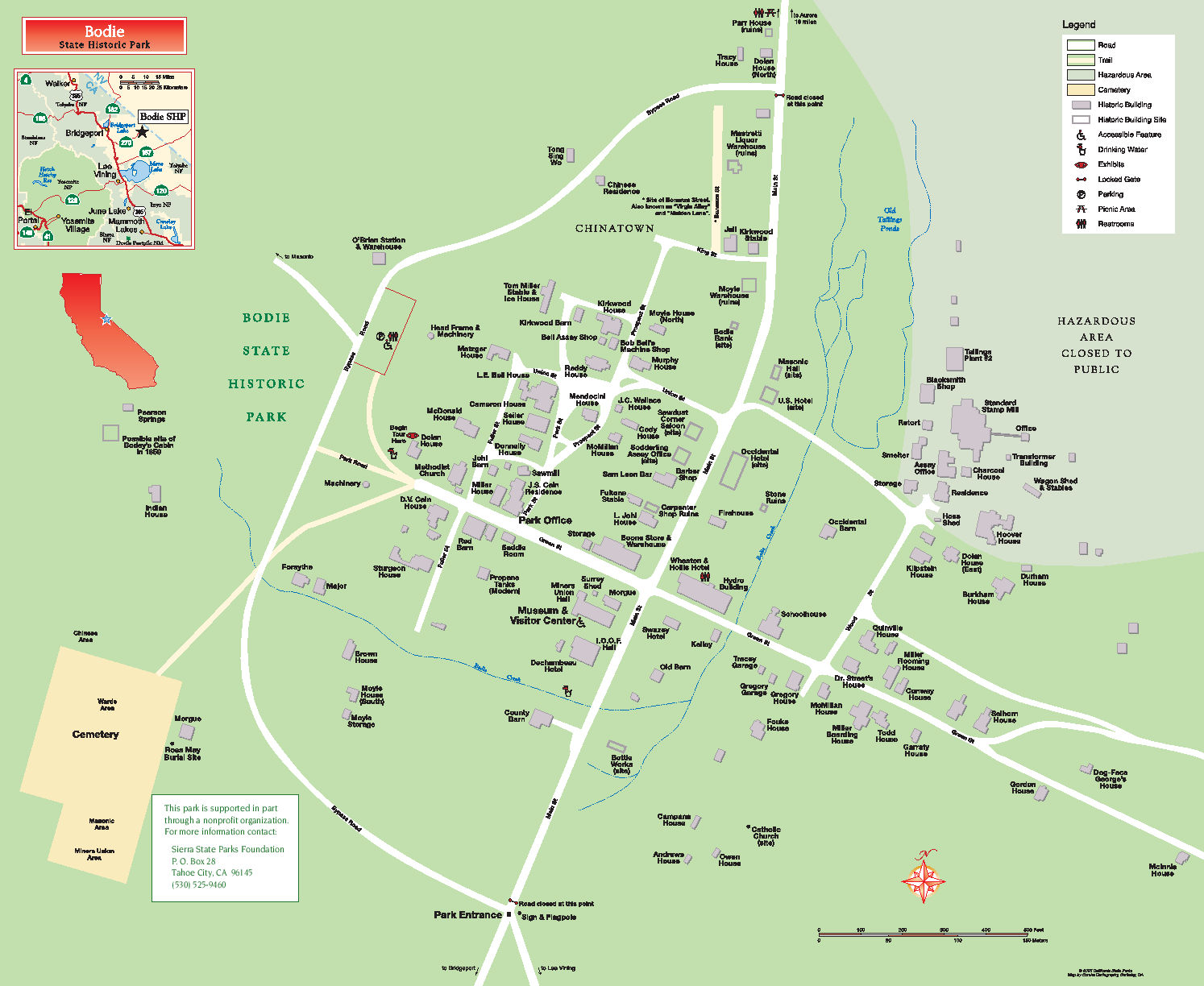
The following video, featuring an interview of a Park Ranger, provides an excellent overview of what is currently available to see.
This video also covers the town very well with a lot of information provided.
These pictures and links to expanded pages cover places to visit in Bodie
Here is a List of the Building in Bodie with information about them.
Bodie Historic State Park - James Stuart Cain Residence
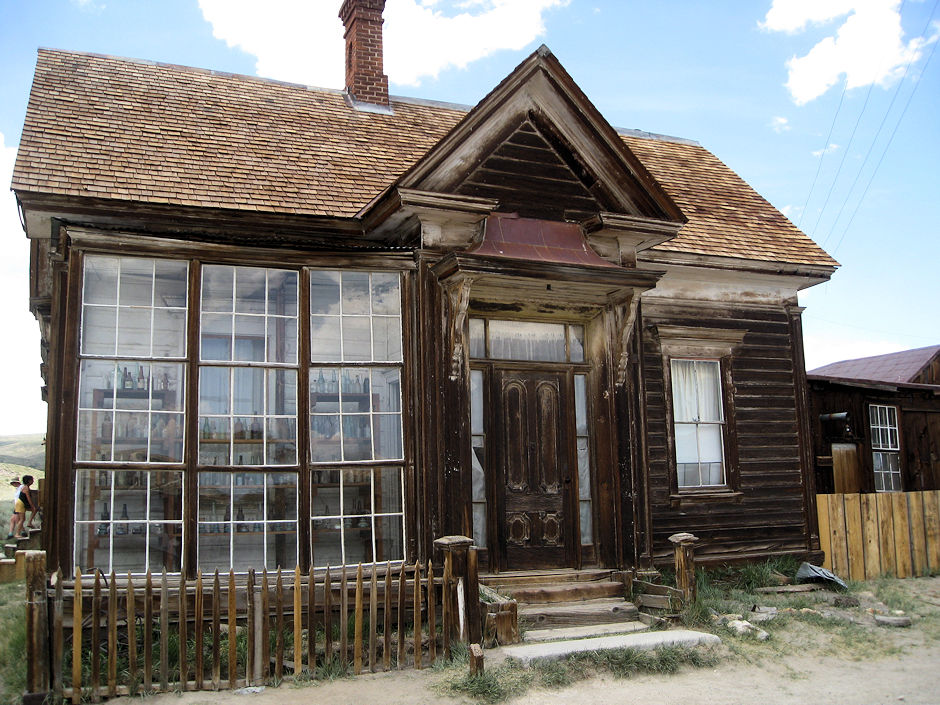
James Stuart Cain residence - Photo by X Trippin , Own work CC BY-SA 4.0, via Wikimedia Commons - Link
Click here for more James Stuart Cain Residence Information
Prominent windows front the finest home in Bodie, owned by James Stuart Cain from the 1890s - 1940s. Jessie McGath originally built this house for his new wife in 1879, and J. S. Cain bought it in the 1890s. We can thank James Stuart Cain for the fact that the ghost town of Bodie is something more than a few derelict buildings sinking into the ground.
Bodie State Historic Park - Bodie Bank
The Bank of Bodie opened on North Main Street in 1878. In 1888, Bodie business mogul J.S. Cain bought half interest in the bank from E. L. Benedict, and, using the fortune he made from mining, completed the purchase in 1890. Cain was a leader in several local industries, including mining and timber, so the Bank of Bodie became a center for business dealings when he took it over.
The bank escaped the fire of 1892, but was destroyed in the fire of 1932 that consumed most of the town. When the building caught fire, a few men rushed to salvage the bank’s valuable walnut counter, only to get it stuck in the door and block themselves from saving anything else.
Before the fire actually got to the bank though, Cain's grand-daughters, Helen and Ruth, got the key to the bank from their grandfather, so they could save some of their favorite items. Cain was sure the bank would be fine, but let them get their things to make them feel better.
According to stories, none of the valuables INSIDE the safe were damaged when the fire leveled the rest of the bank. All that remains of the Bank of Bodie is the brick vault pictured here.
Bodie Historic State Park - DeChambeau Hotel and Independent Order 0f Odd Fellows Buildings
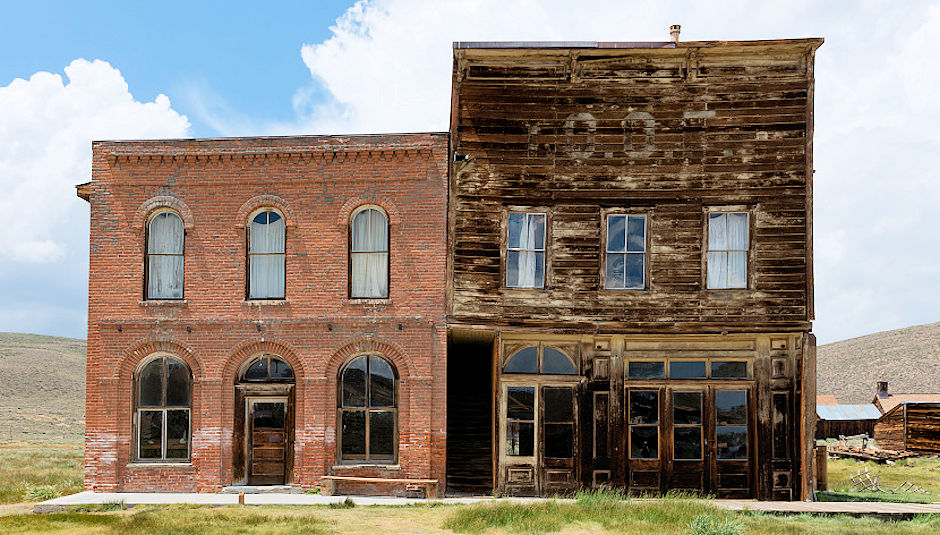
DeChambeau Hotel and Independent Order 0f Odd Fellows Buildings by Carol M. Highsmith 2012 - Library of Congress
Click here for more DeChambeau Hotel and IOOF Building Information
On the left above is the DeChambeau Hotel and on the right the wooden building is the International Order of Odd Fellows (IOOF) building.
One of Bodie's few brick building, the hotel building, built in the early 1870’s, was originally the post office, then converted to a boarding house & later a hotel and then converted into the Bodie Cafe, a bar & cafe that was in business until the early 1930’s - one of Bodie’s last operating businesses.
The IOOF building was constructed in 1880 by H. Ward, who used the first floor for his undertaking business. In later years, the IOOF building was used by the Bodie Athletic Club. Most of the town’s fraternal & town meetings were held here.
Bodie State Historic Park - Miner's Union Hall
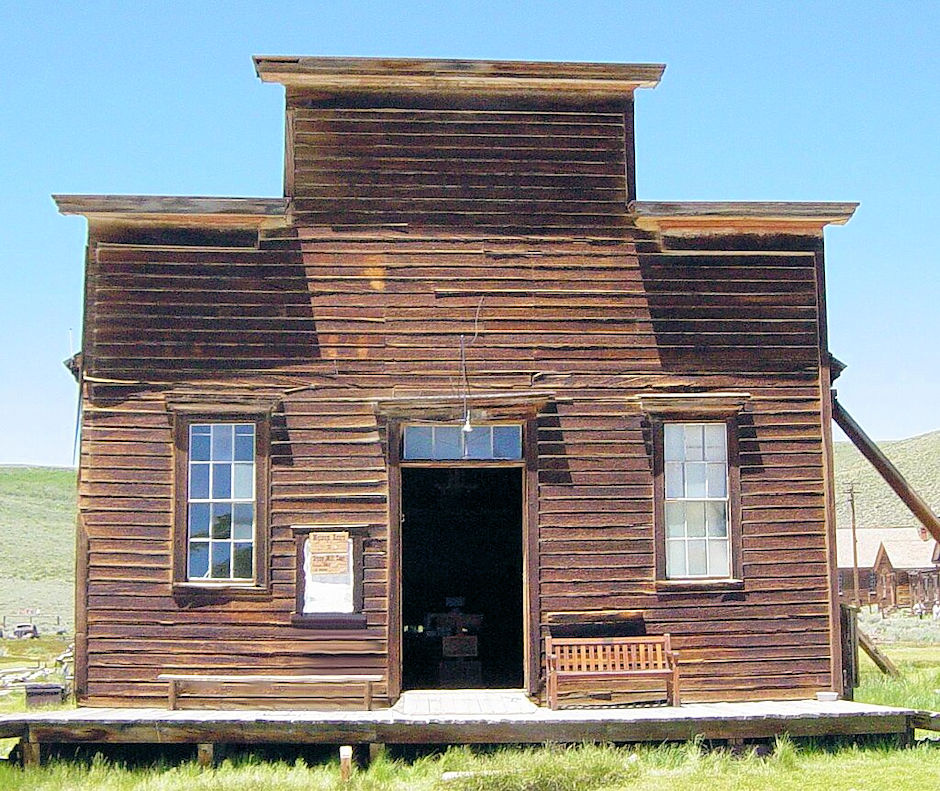
Miner's Union Hall - now museum - Photo by Daniel Mayer - Public domain, via Wikimedia Commons
Click here for more Miner's Union Hall Information
The Miners’ Union Hall, which is now the Park Museum, was completed on June 28, 1878, a year after the creation of the town’s miners’ union. It is a reminder of the ghost town’s rich history of gold mining. The BODIE MINERS’ UNION “Brotherhood of workers” established Bodie as a “Union mining Town”. When the town was bustling with activity, the hall served as a meeting place for the union members and local festivals. Catholic & Methodist services were held before Bodie’s two churches were built in the 1880’s.
In the mid 1940s, Ella Cain is credited for collecting and displaying artifacts. Its use continues today as the Bodie Museum housing everything from documents, artifacts, and photographs, to mining equipment used by the town’s miners back in the day. A little bookstore and souvenir shop at the museum offer tourist information, tickets, and fascinating merchandise.
Bodie Historical State Park - Sawmill and Bodie & Benton Railroad
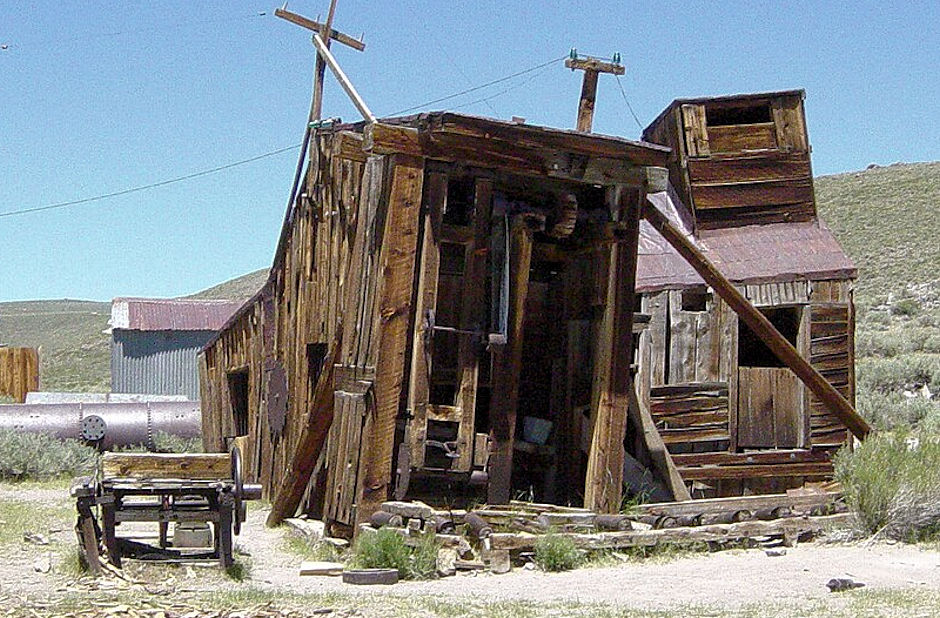
Remains of sawmill in Bodie - remains of Sled Saw on the left and Cross-cut Saw in front
Click here for more Sawmill and Railroad Information
Bodie’s need for lumber to build homes, timber for shoring mines, and wood for fuel was tremendous. During the heyday, over 300 cords of wood A DAY went up in smoke. With no wood in sight of town, the wood hauling business was an exceptional commodity. As the town grew in the late 1870s, wood was brought by wagons from lumber mills in Bridgeport, the Mono Basin and other locations to build structures, keep the ever-growing population warm in winter and to supply the mining district.
Teamsters could not begin to meet the enormous appetite Bodie had for consuming wood. The stage was set for the obvious answer to the problem - build a railroad to the large timber stands south of Mono Lake. The paradox to this picture is the forests of Jeffrey and lodgepole pine a few miles south of Mono Lake.
It is surprising that this country could bear trees, and incredible that they would mature to four feet in diameter. However, the country does, and the trees did, and therein lies the birth of a railroad. As early as the 1860s, men recognized the potential of the vast Jeffery pine forest located over 30 miles south of Bodie, near Mono Lake. The land was acquired in the 1880s by businessmen who filed timber rights on 12,000 acres.
There was a small sawmill in Bodie that was used to break down scrap wood that was brought in by rail for firewood. The trains also brought in sawmill scraps and poor quality lumber from elsewhere in the high Sierra since Bodie had no local trees to burn for heat.
Bodie Historic State Park - Methodist Church
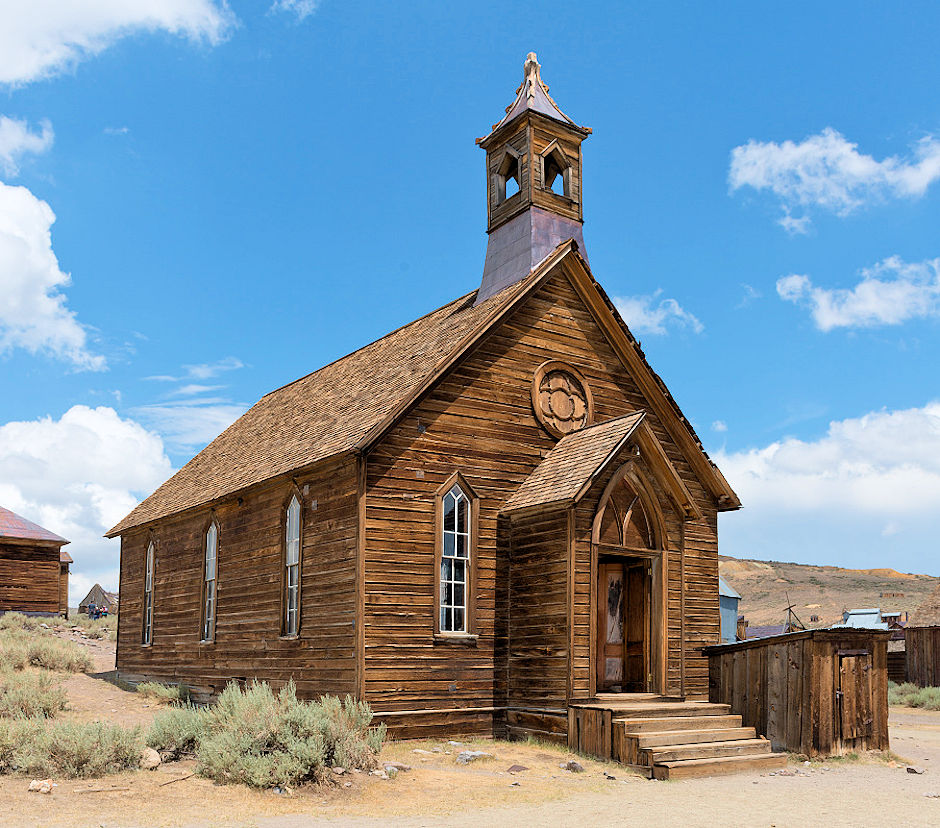
Methodist Church 2012 - Photo by Carol M. Highsmith - Library of Congress
Click here for more Methodist Church Information
As Bodie’s population grew in the late 1870s, those wishing to attend religious services gathered in homes and buildings, such as the Miners’ Union Hall. The heads of the various congregations undertook fundraising activities for the building of church buildings. The Catholic and Methodist congregations were successful in constructing church buildings in 1882. The Catholic church burned down in 1928.
Bodie State Historic Park - Bodie Jail
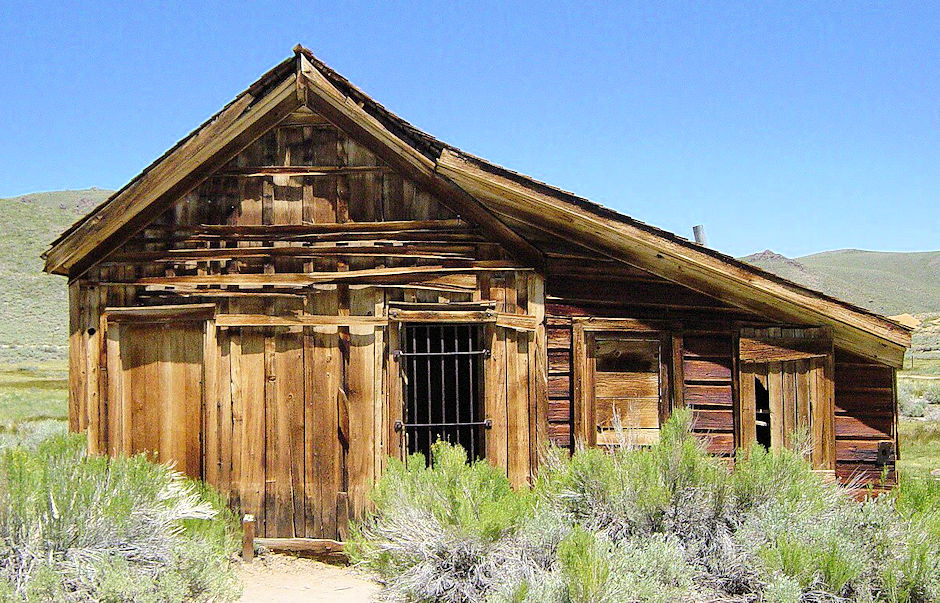
Bodie Jail 2004 - Photo by Daniel Mayer, CC BY-SA 4.0, via Wikimedia Commons
Click here for more Bodie Jail Information
The Bodie Jail was built in 1877 and cost about $800. It’s approximately 14 feet x 18 feet, and has two cells. It’s been written that the jail wasn’t built very well, but it certainly saw a lot of “guests”. Bail was usually $5 for misdemeanors. Only one prisoner has ever been known to escape from this jail. The town was known as being lawless and immoral. One young girl, after finding out her family was moving to Bodie, wrote in her diary "Goodbye God, I'm going to Bodie". John Wayne was here in the early 1970's for a television special.
Bodie State Historic Park - Bodie School House
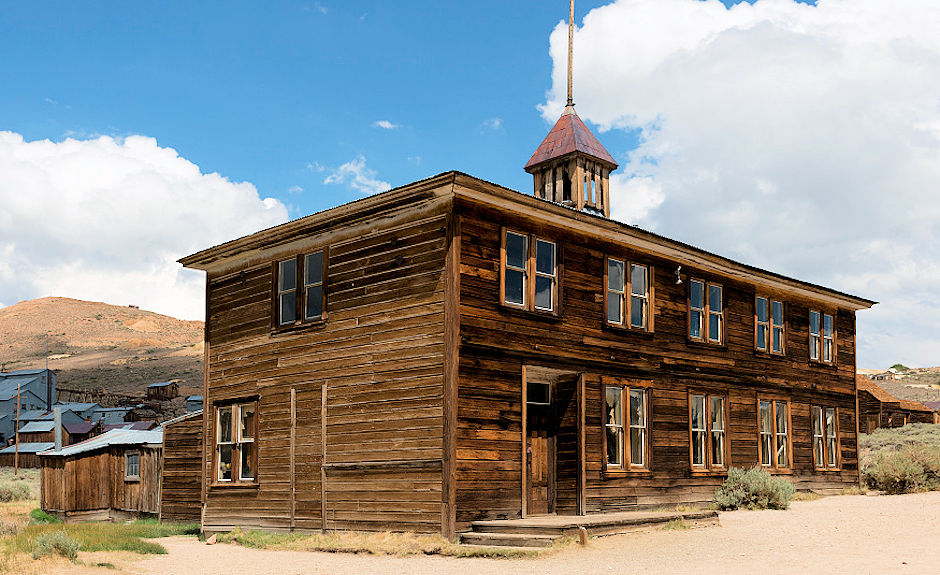
Bodie School Houst 2012 - Photo by Carol M. Highsmith - Library of Congress
Click here for more Bodie School House Information
This large two story wooden building with the belfry on top, moved to this location in 1879, was not the first school in Bodie. The first was most likely the one opened in March of 1878 on Main Street that was taught by Belle Moore, the wife of Ben Butler who owned a saloon also on Main Street.
Then there was one located about two blocks higher up on Green Street. It is said that it was burned down by a small boy who had gotten in trouble, and was sent home. He went to the backside of the school and began setting fire to the dry brush for fun. It spread to the building and burnt it to the ground.
This newer school, which is one of the better looking buildings in town, was originally the Bon Ton Lodging House that had been run in 1879 by Mrs. C.A. Ratjohn. Some of the early teachers were a Mr. Cook and a Mr. McCarty. At its peak enrollment there were three classes - one on the ground floor, one in an addition at the back and one for the older students on the second floor.
Although there were students as old as 16 or 17, there was never a "high school". The school reached its highest enrollment of 615 students. It closed its doors for the last time in 1943.
Bodie State Historic Park - Bodie Fire House

Bodie Fire House 2012 - Photo by Carol M. Highsmith - Library of Congress
Click here for more Bodie Fire House Information
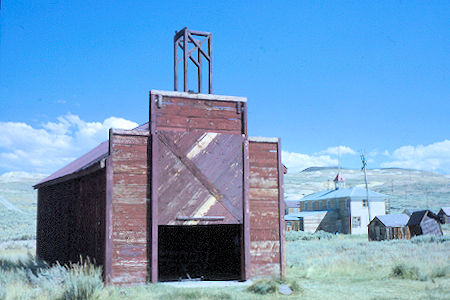
Fire House in front with School House in back - August 25, 1962
Here stands the lone Bodie fire station in a town frozen in time. Once nestled between other wooden buildings of the like, it now stands as a memorial to the once booming town.
At one point in time, there were four fire companies for Bodie! At one point, a fire broke out at the Central Market, and all four companies came to the rescue. There wasn’t a problem until they all tried to hook up their hoses to the hydrant. Who had the authority!? Who was going to be the one to put the fire out!?
Luckily for Bodie, shortly thereafter, all four companies were combined into one and fire districts were laid out for them to serve.
On the night of August 10, 1941, the bronze bell from the firehouse belfry was stolen. Soon after, on September 28, 1941, it was returned to Bodie and is still on display today. Note that it is missing from the 1962 picture at the right. The State Park people were just taking possession of the town and eventually put the bell back up.
Bodie Historic State Park - Land Office, Power Company Office, Bodie Store
Wheaton and Hollis Hotel
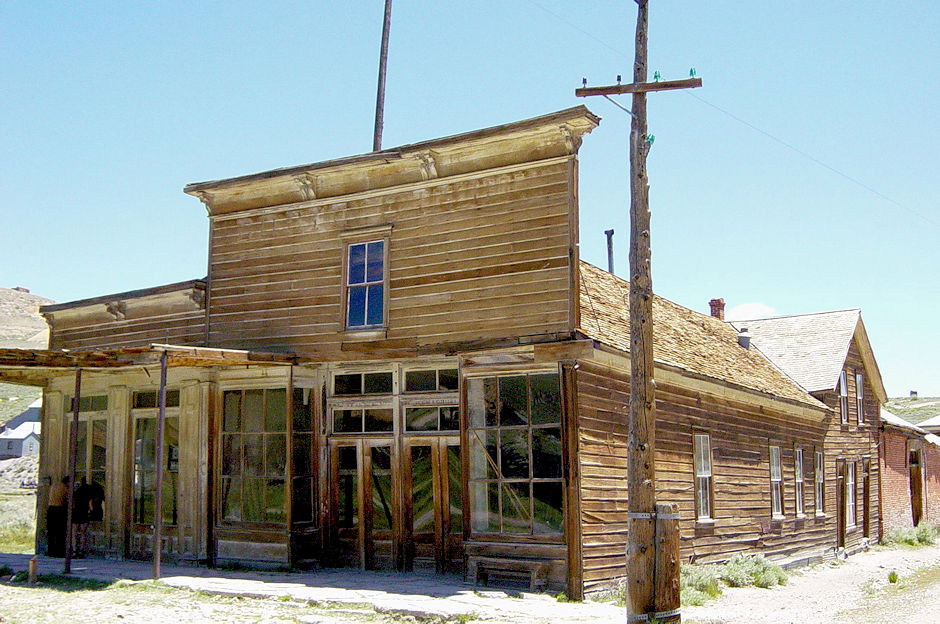
Land Office, Power Company Office, Bodie Store, Wheaton and Hollis Hotel
Photo by Daniel Mayer - Own work, CC BY-SA 4.0, via Wikimedia Commons - Link
Click here for more Land Office, Power Company Office, Bodie Store, Wheaton and Hollis Hotel Information
In 1885-86, this building served as the United States Land Office. The Land Office was established on January 5th, 1879 and was moved here later. Starting about 1893 it served as the Power Company Office and later a boarding house - The Wheaton and Hollis Hotel.
Bodie State Historic Park - Standard Stamp Mill
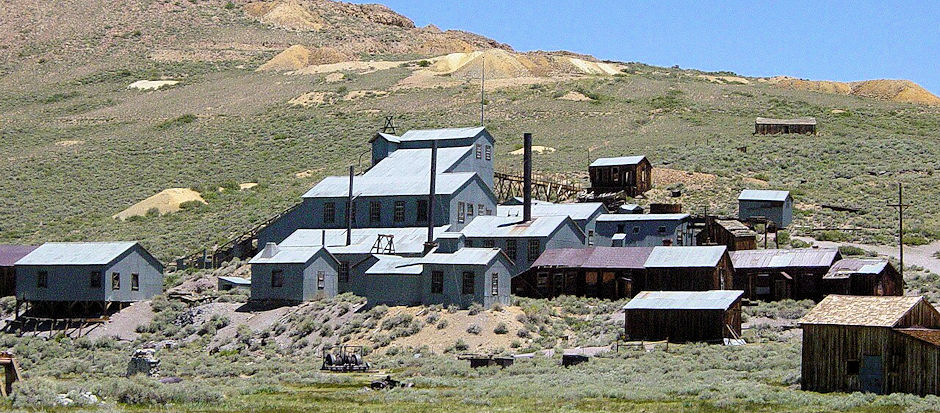
Standard Mine and Stamp Mill - Photo by Michele Debczak
Click hear for more Standard Mill Information
Aerial view of the Standard Stamp Mill facility
The mine was known as the Bunker Hill Mine when it was registered in July 1861. It passed through several hands before being sold for $67,000 to four partners who changed the name and incorporated as the Standard Consolidated Mining Company in April 1877. Read about History regarding Discovery of the Standard Mine.
The Standard Mine yielded nearly $15 million over 25 years, and its success caused the 1878 rush to Bodie. Within a year, the population rose from about 20 to an estimated 10,000 miners, gamblers and other entrepreneurs.
The mill was destroyed by fire in 1898, but was rebuilt the following year. Between 1860 and 1941, the Bodie Mining District produced close to $100 million in gold and silver. During those years, gold prices ranged from $20 to $35 an ounce; the price of silver ranged from 70 cents to $1 an ounce. The mill last operated in 1938. The Standard was the most successful of the 30 different mining companies that operated in the Bodie Mining District.
Text from the Bodie State Historic Park tour book
Bodie State Historic Park - Bodie Cemetery
When visiting Bodie make sure to visit the cemetery. The State Park and Bodie Foundation have on-going work gathering information about the grave sites and repairing grave markers. The historic cemeteries at Bodie contain stone markers and monuments. Many are damaged, suffering from vandalism, weathering, erosion and deterioration. Prior to about 1949 more than 200 burial sites were identified. About 2008 the Institute of Canine Forensic Team was utilized to locate over 500 unmarked graves. The State Park contracted with EverGreen Archetectual Arts to assess the conditions and make treatment recommendations, and implement treatment for 22 stone grave markers at the Bodie Cemetery.
Favorite Story From Bodie Foundation
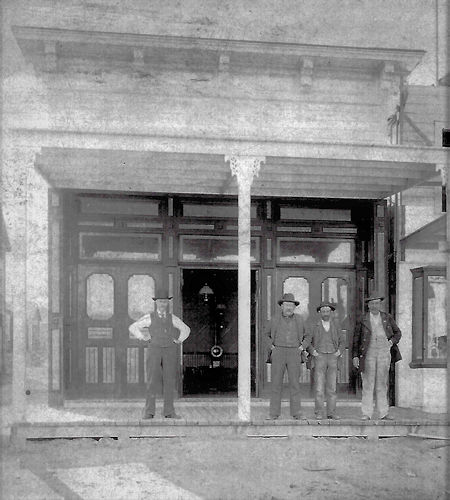
A group of men pose outside the Cabinet Saloon on Bodie’s Main Street in the 1880s. We have a rare glimpse of the interior behind the men. Later, this building would become the Sawdust Corner Saloon. Bodie’s most disastrous fire on June 23, 1932 was started by a young boy playing with matches behind the saloon. Bodie Foundation Collection
One of our favorite accounts of Bodie is this address delivered before the California Historical Society in 1924 by Grant Smith. This is an excerpt of the original speech.
Bodie is an unforgettable memory. After more than forty years, it gives me a thrill to speak of it. I went there as a boy of fourteen in June 1879, when the camp was in its glory, and left in 1881, before the rapid decline had fairly set in; consequently, I remember only its golden days.
The winter of 1878-1879 was a terrible one. Until the “excitement” arose, the camp was comparatively small, and accommodations were of the poorest sort. However, early in the spring of 1879, great quantities of materials and supplies were rushed in; and thousands of people came also. When I reached Bodie in June 1879, the terrors of the preceding winter had been forgotten, building was going on everywhere, new mines were being opened, new hoisting works erected, and new mills were being built.
The traffic in the streets was continuous and enlivening. There were trains of huge, white-topped “prairie-schooners” bringing freight from the railroad, each drawn by twenty or more horses or mules; ore-wagons hauling ore down the canyon to the mills; wood wagons bringing in huge loads of pine-nut wood from long distances for the mines and mills and general use; hay wagons, lumber wagons, prospecting outfits, spanking teams driven by mine superintendents, horses ridden by everybody and, most exciting of all, the daily stages that came tearing into town and went rushing out. The outgoing stages often carried bars of bullion, guarded by stern, silent men, armed with sawed-off shotguns loaded with buckshot. They did not always succeed in protecting their treasure.
The streets were alive with men at all times of the day and night. The saloons and gambling houses all fronted on the main street. Nearly everybody drank, nearly everybody gambled.
There was poor housing, limited water supply, no sanitary regulations, a harsh climate, forbidding surroundings and no warm, cheerful comfortable places to go except the saloons, the gambling halls, the dance-houses and the red-light district — all leading to drink, to gambling, and to excesses of every kind.
I do not know how many men were killed in John Wagner’s saloon. It was a typical mining camp saloon, somewhat larger than any of the others. To the left of the swinging doors, as you entered, was the bar, stretching along the side of the room. Opposite the bar and stretching along in similar fashion was a chop house or short-order restaurant with a long counter and stools in front. The rear of the room was literally filled with gambling tables of one kind and another, principally faro banks, presided over by the silent, watchful dealers, with hundreds, or even thousands of dollars in gold and silver stacked up in front of them and a gun always within reach.
There would be hundreds of men every night in John Wagner’s saloon. When a shot was fired, the crowd would make a mad rush for the front doors. Many times, John Wagner’s front doors were carried bodily out into the street by these stampeded crowds, eager to escape the flying bullets. John Wagner himself was stolid, sober, thrifty experienced German saloon keeper, who remained unperturbed during the wildest excitements. His wife was a physician and devoted her life to ministering the unfortunate and needy, without pay. Her home was just back of the saloon, on a short street that was the outlet of Chinatown and red-light district – and a fearsome street it was.
Whiskey was the common drink – beer and wine were too insipid for these tough stomachs – and much whiskey led to quarrelling and gun-fighting. Fortunately, the fighting was almost entirely confined to the rough element and so long as they killed off one another, the better citizens did not care. Every once in a while, an innocent spectator would get in the way of a bullet, but that was considered partly his own fault for being there.
These links will take you to some excellent historical references and picture collections:
- The non-profit Bodie Foundation has pictures and information and assists in the preservation efforts. There are a large number of photos starting in 2012 on the Bodie Foundation Facebook page. There is also a collection of Bodie Foundation videos
- The Library of Congress has a collection of 386 pictures covering Bodie including the Standard Stamp Mill
- This brochure provides information including a map
- This MishMoments Collection includes some incredibly beautiful pictures - and more mishmoments.com
- You will find more information about Bodie here on Wikipedia
- here on Beyond Nevada Expeditions
- here on Bodie History
- here on Facebook
- here on Wondering Through Time and Place
- Legends of America has an excellent narrative of Bodie's history including pictures
- Daniel Mayer Gallery - Wikemedia-Commons
- MishMoments Collection includes some incredibly beautiful pictures
- Greatest Paka Photography has an excellent set of Bodie pictures
- History article with text and pictures
- Frasher Foto Postcard Collection - photos by Burton Frasher and Digital Desert - Bodie Historic Photos - assorted photos by Burton Frasher
- A History of Chinese Americans in Bodie
- WikiMedia Commons large picture collection
- Bodie travel article which nice pictures
- Good Bodie History article with some nice pictures
- Adventure Bible School article with some interesting pictures
- Western Mining History picture collection
- Here is a collection of Bodie State Park videos which you can watch
- A search of the internet will bring up many more sites to look at
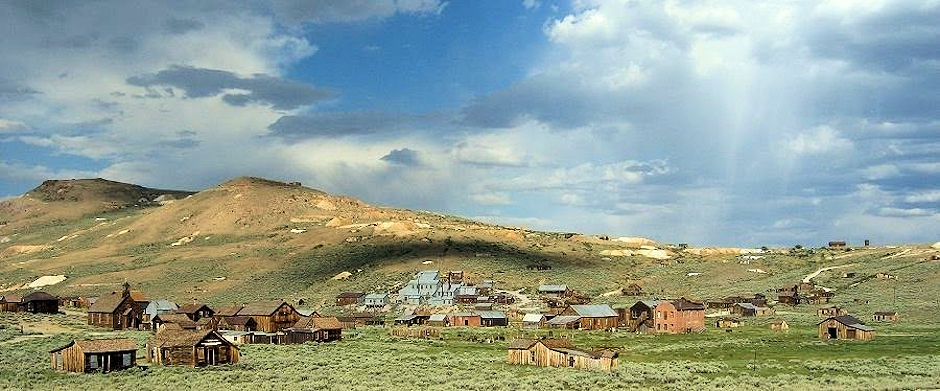
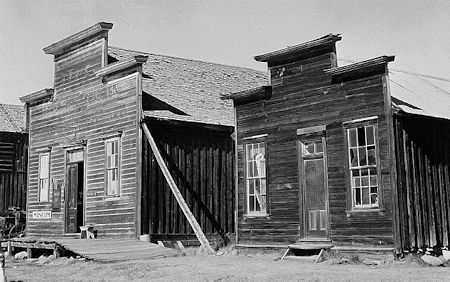
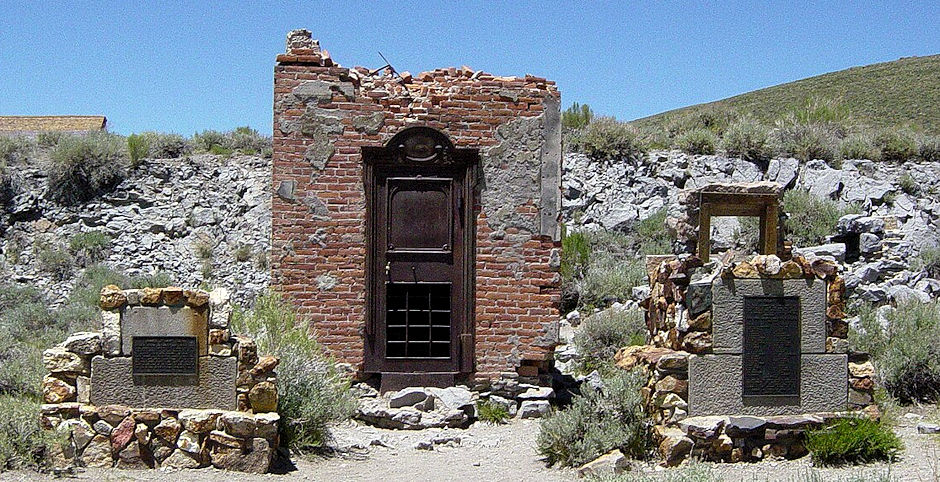 Bodie Bank vault remains -
Bodie Bank vault remains - 